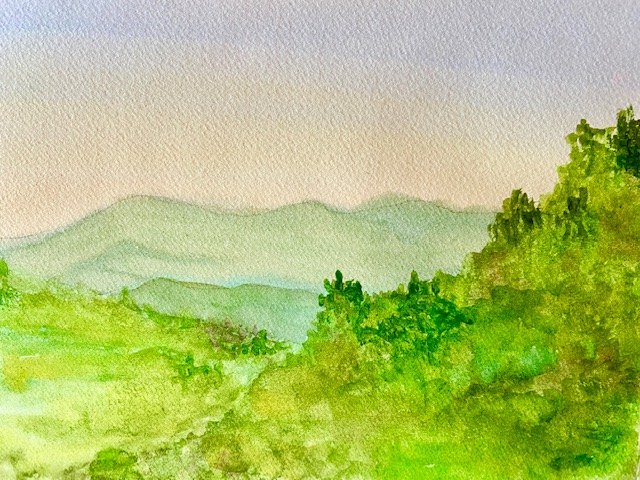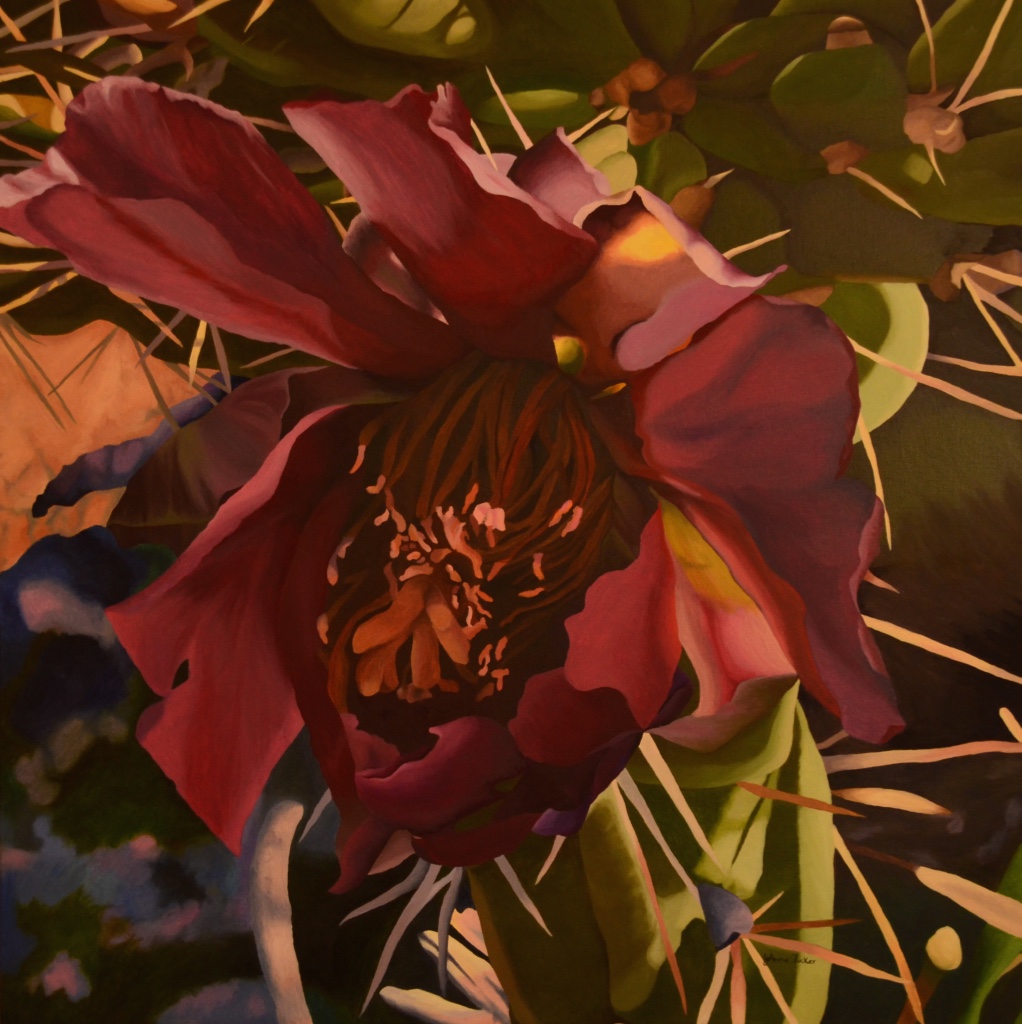Moving to Costa Rica, I brought a few watercolor supplies with me and thought that I might like to experiment with this medium. When I saw that Eric Rhoads had put together an event called Watercolor Live. I decided to check it out so that I might learn some basic skills! The first day was for beginners and then there were three days that followed, pitched to all levels of watercolor painters. I definitely was a beginner so I knew that I would sign up for the first day, and then I thought why not just sign up for the full event? I am so glad that I did.
First of all, I was familiar with the quality of events that Eric Rhoads puts together, having attended a Plein Air 4-day event in Santa Fe held at Buffalo Thunder a few years before. I had learned a lot and thoroughly enjoyed it. The artists that he put together for the event were first rate and I was familiar with several of them prior to attending. In December I spent some time at the website for Watercolor Live where I could see the excellent quality of artists who would be demonstrating during the 4 days of the virtual event[.
There were so many pluses for signing up. First of all there was no way that I could attend any kind of live art event, even here in Costa Rica, because of COVID!! Second, I was getting frustrated with my limited knowledge, and so far my watercoloring was limited to making very simple Christmas cards for friends and workers here in Costa Rica. Third, I was hungry for some stimulation. My husband, Murray, had passed away in the fall and so much time was being spent on handling business things that needed to be done, that a change of pace was definitely important.
So I signed up and wow what an excellent experience. I loved spending four days from 10 AM to 10 PM just thinking about ART. It was non-stop and only occasionally did I pause to take a quick swim in the pool or to walk around the house a bit. I was mesmerized by the variety of different demonstrations. There are three options for buying the event. I had selected the middle option where I can go back and replay segments for 60 days. I am satisfied with that choice as there are quite a few sections that (although interesting) I have little desire to replay, but there are quite a few that I look forward to going back to and watching maybe several times. Beside the formal demonstrations there were other elements that stood out for me.
Suppliers of watercolor brushes, paper and paint presented segments too. And they weren’t just commercials. Instead, they often had an artist explain a technique or show how a product could be used. The first day began with basics about Understanding Materials. It was a perfect way to begin and even more important, it introduced me to Birgit O’Connor, whose floral watercolor paintings are breathtaking. She offers online courses that I might consider taking, down the road. The next session, by Kim Minichelle, related to color mixing and working with a limited palate, and was also very on target. Shuang Li’s demonstration on basic washes was one of the few demonstrations where I decided to paint along with her as she demonstrated. I did of course spend time later working on some of her techniques and have used them in the beginning paintings I have done. Another highlight from the first day was a critique session led by Antonio Masi. As he commented on some watercolor paintings that participants had submitted I realized what had been bothering me about an oil painting that I had almost completed but which I knew had problems!! That evening I figured out what I needed to do to improve the composition of an oil painting inspired by several orchids and while I didn’t get to it until after the four-day workshop was over, the key to solving the problem was learned in Masi’s critiquing session.

Completed February 2021 after hearing Masi’s critique session.
In fact, one of the best things about the workshop was that it wasn’t only about watercolor paintings; it was about art in general. I was constantly reminded how important it is to continue to work on my sketching skills and to regularly evaluate the composition of my paintings. Also stressed was the importance of spending two hours a day painting even when not inspired.
One of the things that doesn’t work for me and which even now I have no desire to do, is to paint along or copy someone’s painting. I am sure that one can learn techniques in doing this but it is an uncomfortable exercise for me. My preference is to watch and see what I can take away and maybe explore as one aspect or new technique of the painting and then to apply it to my own compositions. I will continue to do that over the next few weeks as I replay. I am also thrilled to have so many good painters’ websites to explore.
Each day there were breakout groups of about 8 people, where for about 25 minutes we could meet other participants from around the world. We could learn about what kind of work they were doing and sometimes see examples of their art work. Most of the break sessions were good but occasionally someone dominated and that took away from a real sharing. We were regularly warned about not doing that. On the whole most people were respectful and I felt it was valuable to participate. I attended almost all of the 8 breakout groups that took place, spread out during the 4 days.
Another very nice element of the event was that all of the demonstration had been pre-recorded and the artist participated in a chat so that students could ask questions during the demonstration, similar to what happens if one is attending a live event!
During the three days of the regular event there was a great variety of presentations, from portrait painting, landscape both plein air and from photographs, cityscapes and a final seascape from well known Australian painter Joseph Zbukvic, truly a master! It was exciting to see so many different techniques and so many fine painters.
Just as I know from my dance days how important it is to be totally immersed in dance, so I felt that same energy being engaged in art even though it was virtual. I came away refreshed and inspired and already I can see a big difference in how I am working in the medium of watercolor.
I highly recommend participating in the events that Eric Rhoads puts together. He just recently had to cancel this year’s Plein Air event scheduled to meet in Denver, for the second year in a row. He had already put together a virtual plein air event (https://pleinairlive.com/2021-register) that was going to be held anyway based on the enthusiasm of last year’s participants. That is the next main event he has planned. In addition to planning this virtual event he has held daily events for artists through the pandemic called Live With Eric Rhoads. Participating when they are happening can be done via Facebook and there are replays available at YouTube at Streamline Art Video Channel.
Eric is a real gift to artists as he has really figured out ways to reach artists during COVID and as a result is getting a worldwide following. He is himself a studio and plein air painter who has made his living as publisher of PleinAir magazine and Fine Art Connoisseur magazine as well as publishing a series of videos, putting on conferences, and writing his own book related to art marketing. At the end of each day he held a “virtual cocktail party” via Zoom where he talked to different participants. A setup was also available so that one could paint at this time as well! I enjoyed doing that the first day and had fun when he called on me to share what I was painting and where I was from. It was fun to share I was in Costa Rica and learn of his enthusiasm for possibly bringing a group to paint in Costa Rica. Right now he has a tour planned for Russia.
To conclude I share two recent watercolor paintings I have done, inspired by views here on the property. A big leap from the little Xmas cards I had been doing. I look forward to seeing where my skills go as I study the sessions and learn more techniques I can incorporate into my landscape paintings inspired by the beautiful property I am very grateful to live on.

Completed February 2021

Completed February 2, 2021
[print_link]

















